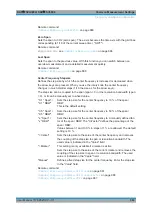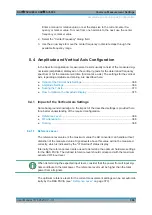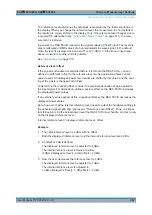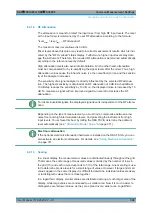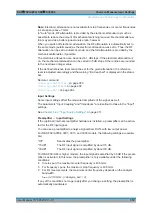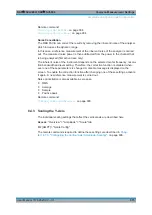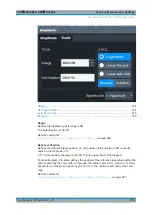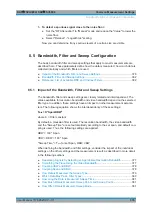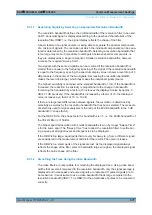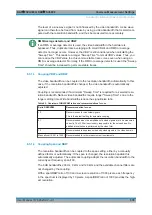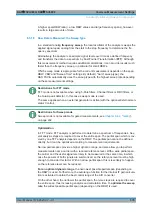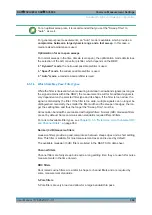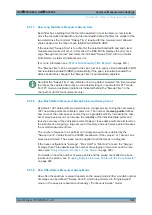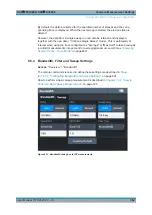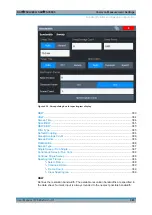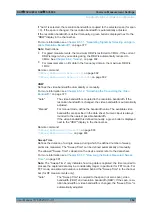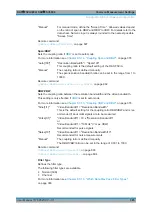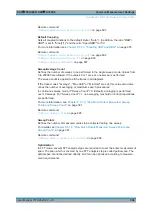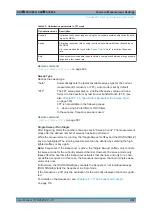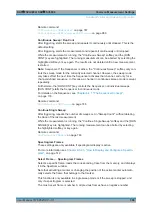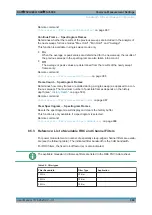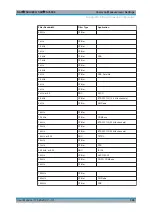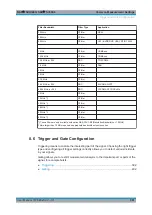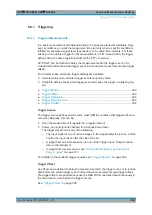
Common Measurement Settings
R&S
®
FSVA3000/ R&S
®
FSV3000
377
User Manual 1178.8520.02 ─ 01
8.5.1.1
Separating Signals by Selecting an Appropriate Resolution Bandwidth
The resolution bandwidth defines the 3 dB bandwidth of the resolution filter to be used.
An RF sinusoidal signal is displayed according to the passband characteristic of the
resolution filter (RBW), i.e. the signal display reflects the shape of the filter.
A basic feature of a signal analyzer is being able to separate the spectral components
of a mixture of signals. The resolution at which the individual components can be sepa-
rated is determined by the resolution bandwidth. Selecting a resolution bandwidth that
is too large may make it impossible to distinguish between spectral components, i.e.
they are displayed as a single component. Smaller resolution bandwidths, however,
increase the required "Sweep Time" .
Two signals with the same amplitude can be resolved if the resolution bandwidth is
smaller than or equal to the frequency spacing of the signal. If the resolution bandwidth
is equal to the frequency spacing, the spectrum display screen shows a level drop of 3
dB precisely in the center of the two signals. Decreasing the resolution bandwidth
makes the level drop larger, which thus makes the individual signals clearer.
The highest sensitivity is obtained at the smallest bandwidth (1 Hz). If the bandwidth is
increased, the reduction in sensitivity is proportional to the change in bandwidth.
Increasing the bandwidth by a factor of 3 increases the displayed noise by approx. 5
dB (4.77 dB precisely). If the bandwidth is increased by a factor of 10, the displayed
noise increases by a factor of 10, i.e. 10 dB.
If there are large level differences between signals, the resolution is determined by
selectivity as well as by the resolution bandwidth that has been selected. The measure
of selectivity used for signal analyzers is the ratio of the 60 dB bandwidth to the 3 dB
bandwidth (= shape factor).
For the R&S
FSV/A, the shape factor for bandwidths is < 5, i.e. the 60 dB bandwidth of
the 30 kHz filter is <150 kHz.
The higher spectral resolution with smaller bandwidths is won by longer "Sweep Time"
s for the same span. The "Sweep Time" has to allow the resolution filters to settle dur-
ing a sweep at all signal levels and frequencies to be displayed.
If the RBW is too large, signal parts that are very far away (e.g. from a different signal)
are considered in the measurement and distort the results. The noise increases.
If the RBW is too small, parts of the signal are lost. As the displayed signal always
reflects the shape of the filter, select a bandwidth large enough so the displayed signal
reflects the entire shape of the filter.
8.5.1.2
Smoothing the Trace Using the Video Bandwidth
The video filters are responsible for smoothing the displayed trace. Using video band-
widths that are small compared to the resolution bandwidth, only the signal average is
displayed and noise peaks and pulsed signals are repressed. If pulsed signals are to
be measured, it is advisable to use a video bandwidth that is large compared to the
resolution bandwidth (VBW = 10 x RBW) for the amplitudes of pulses to be measured
correctly.
Bandwidth, Filter and Sweep Configuration

